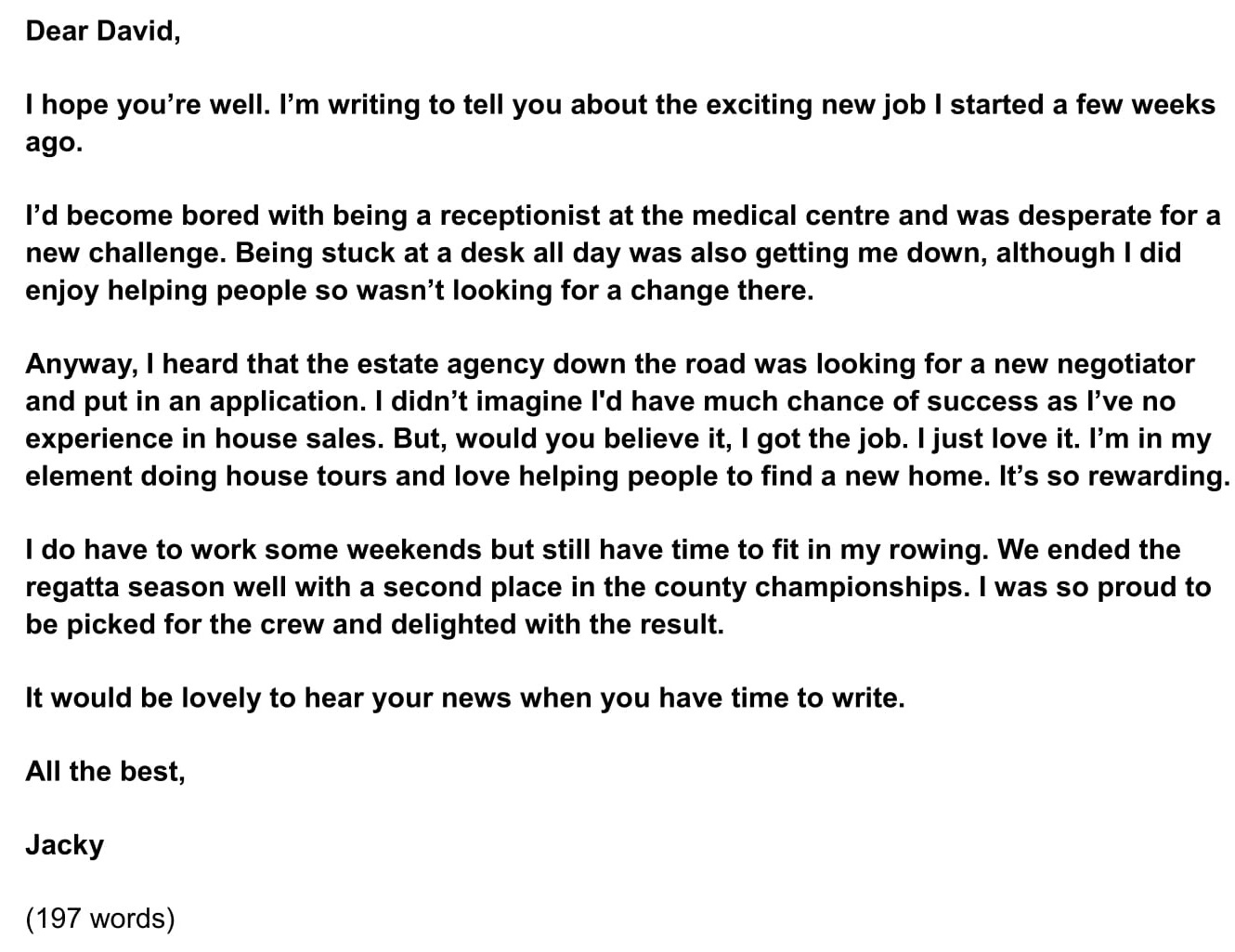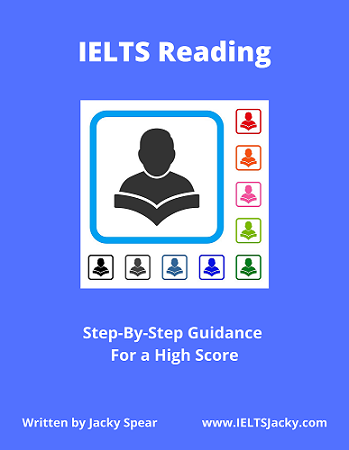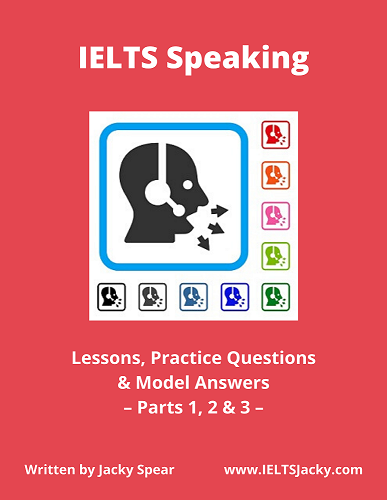How To Write an
Informal IELTS Letter
The key to writing a high-scoring informal IELTS letter is to get the structure right so this is what we will start with.
This lesson will also take you step-by-step through the process of writing an informal letter.
Here’s what we’ll be covering:
- 6 part letter structure
- Formal or informal? – how to tell the difference
- 4 simple steps of letter planning
- Sample letter
Simple 6 Part Structure
You can use the same basic structure for answering both an informal IELTS letter and a formal one. Ideally, your essay should consist of 4 paragraphs with a greeting at the beginning and a signoff at the end.
1) Dear .....
2) Paragraph 1: Purpose – why you are writing
3) Paragraph 2: Write about 1st bullet point
4) Paragraph 3: Write about 2nd bullet point
5) Paragraph 4: Write about 3rd bullet point
6) Signoff
With only 20 minutes allowed for the task and a requirement of just 150 words, you won’t be able to include much detail.
The main paragraphs (2, 3 and 4) only need to be around 50 words each. Aim for quality in your letter, not quantity – the right information written in a logical order. Having a structure to work with will help you achieve this.
Formal or Informal?
How To Tell The Difference
Your first task is to decide if the question requires you to write an informal IELTS letter or a formal letter. It’s essential to get this right or you'll get a low score for Task Achievement.
The two types of letter have a very different tone and style and the language you use will also vary.
It’s very simple to tell the difference. Follow this rule:
- If the question includes the word ‘friend’, use informal language.
- If the question does not include the word ‘friend’, use formal language.
The only exception is if the letter is to a close family member when you would also use an informal tone, but these are not common.
Here’s an example of a question that requires and an informal letter. Note the inclusion of the word ‘friend’ in the second sentence.
You have recently started working for a new company.
Write a letter to a friend. In your letter:
- Explain the reasons why you changed jobs
- Describe your new job
- Tell him/her your other news
I’ll be using this question to show you step-by-step how to write an informal letter.
4 Simple Planning Steps
It is essential to plan your letter before you begin writing. Planning will:
- Save you time
- Result in a more relevant answer
- Help you to meet the marking criteria
There are 4 steps to writing a good informal IELTS Letter.
# 1 Understand the topic
# 2 Identify who you are writing to
# 3 Identify the 3 things you must write about
# 4 Generate ideas
Once we’ve completed this quick and simple process, we’ll be ready to write a high-quality letter.
# 1 Understand the topic
The topic of the question will be stated in the first sentence of the question. Here's the topic sentence from our sample question:
You have recently started working for a new company.
This is what your letter will be about. It is the purpose for you writing the letter and must be stated in the first paragraph. For example,
I'm writing to tell you about my exciting new job.
Many students make the mistake of missing this purpose sentence out. Including it will gain you marks.
# 2 Identify who you are writing to
The person you are required to write your letter to will be stated in the second sentence of the question.
Write a letter to a friend.
The appearance of the word ’friend’ confirms that, in this instance, we must write an informal letter.
# 3 Identify the 3 things you must write about
You must include 3 things in your letter. They will be shown in the 3 bullet points in the question:
- Explain the reasons why you changed jobs
- Describe your new job
- Tell him/her your other news
You don’t need to write about anything else.
# 4 Generate ideas
Finally, we must think up some ideas related to each bullet point. If we do this before we start writing, we’ll know what we're going to say and won’t need to keep stopping to think about the next idea.
With only 150 words to write, you won’t need many ideas. Just make sure that you write about each bullet point and develop each idea fully.
Here are a couple of tips to help you:
- Write about a personal experience if possible.
If you have experienced a similar situation to the one you have to write about, use this for your ideas. It will make planning quicker and help you to use natural language.
- You get marks for relevant ideas, not clever ideas.
Your ideas do not have to be the best you can possibly think of. They just need to relate directly to the bullet points. Go with your first thoughts and don’t waste time trying to think of better ideas.
Note your ideas beside each bullet point on the exam paper, like this:
- Explain the reasons why you changed jobs
Bored with job as medical centre receptionist. New challenge. Not stuck in office all day.
- Describe your new job
Estate agent. Showing clients around houses.
- Tell him/her your other news
Still enjoying rowing. Rowed in the county championships – second.
We’ll now add all this detail to the letter structure. When you practice, do this as you work through the planning process.
Here’s a reminder of the letter structure:
1) Dear .....
2) Paragraph 1: Purpose – why you are writing
3) Paragraph 2: Write about 1st bullet point
4) Paragraph 3: Write about 2nd bullet point
5) Paragraph 4: Write about 3rd bullet point
6) Signoff
And here is the structure with the detail added:
1) Dear .....
2) Paragraph 1: Purpose – You have recently started working for a new company.
3) Paragraph 2: Explain the reasons why you changed jobs
Bored with job as medical centre receptionist. New challenge. Not stuck in office all day.
4) Paragraph 3: Describe your new job
Estate agent. Showing clients around houses.
5) Paragraph 4: Tell him/her your other news
Still enjoying rowing. Rowed in the county championships – second.
6) Signoff
Spending a few minutes creating this plan will enable you to write much faster than if you don’t have a plan and will also result in a higher quality letter.
Greeting & Signoff
The two parts of the informal IELTS letter structure I haven’t mentioned yet are the ‘greeting’ and the ‘signoff’.
The Greeting
Always start your letter with ‘Dear...’ followed by the first name of the friend, e.g.
Dear David,
You probably use ‘Hi...’ and ‘Hello...’ in emails and texts but for letters, ‘Dear...’ is more appropriate, so stick with this.
It can be helpful to use the name of a real friend who you imagine you are writing this letter to. This will make it easier to sound natural than if you write the letter to an imaginary friend.
The Signoff
You must sign off your letter correctly. Use one of these phrases followed by your first name.
- All the best
- See you soon
- Keep in touch
For example,
All the best,
Jacky
Never add your surname when writing to a friend.
Informal IELTS Letter
Here’s an example of an informal IELTS letter written following the guidelines and structure in this lesson.
You'll notice that I've used contraction (e.g. you're, I'm, I'd). Contractions are the easiest way to show the examiner that you know you are writing an informal letter.

This sample informal
IELTS letter is well over the minimum word limit so you can see that you don’t
have space to include very much detail at all.
Now use what you’ve learnt in this lesson to practice answering other informal letter questions. Start slowly at first and keep practicing until you can plan and write a complete letter in around 20 minutes.
There are lots more tips and help on writing informal IELTS letters in the lessons below.
|
Want to watch and listen? Click on this video. |
Like this page?
IELTS General Writing Task 1 – All Lessons
IELTS General Writing – A summary of the test including important facts, test format & assessment.
Letter
Format – The format, the 7 topics, letter
structure, formal & informal, assessment & marking criteria, sample
questions. Essential information you need to know.
Letter Writing Tips – Learn top tips on how to meet the assessment and marking criteria and achieve a high score.
Letter Writing Structure – Find out how to use this easy to learn letter structure to write a high-scoring letter. Includes a model answer.
How To Plan a Letter – Learn a simple 5 step process & 6 part letter structure. Also, help to understand the question & generate ideas.
Formal or Informal – How to decide what type of
letter to write. Sample questions & 2 model letters.
Letter Writing Vocabulary – Learn useful phrases to help you achieve a high score. Also, know how to start & end your letter.
How To Write an Informal Letter – Step-by-step instructions, simple 4 step plan & 6 part letter structure, model letter.
How To Write a Formal Letter – Step-by-step instructions, simple 4 step plan & 6 part letter structure, model letter.
Letter Topics – Learn the 7 most common letter topics & other popular subjects. Includes 20 sample questions.







